Townsend Courtney M.Jr., Evers B. Mark. Atlas of General Surgical Techniques: Expert Consult
Подождите немного. Документ загружается.


1042
STEP 1: SURGICAL ANATOMY
◆ A comprehensive understanding of the anatomy of the thigh and knowledge of the pre-
existing level of circulation is critical before undertaking amputation of the leg.
◆ Figure 94-1 demonstrates key anatomic structures that must be considered with supracon-
dylar amputation, including the relationship of the femur with the surrounding vessels.
STEP 2: PREOPERATIVE CONSIDERATIONS
◆ Select the level of amputation that will optimize healing and preserve as much function as
possible.
◆ The indications for supracondylar amputations include the following:
◆ Nonambulatory, debilitated patient with indication for amputation with high risk for
developing fl exion contracture of the knee after below-knee amputation.
◆ Debilitated patients with knee joint contracture and/or nonviable calf muscle or skin for
creation of the below-knee fl ap.
◆ Failure of a bypass graft.
◆ Failure of below-knee amputation.
◆ Severe ischemia, necrosis, infection, joint contractures, neoplasm, trauma, and crush in-
juries involving the calf or distal thigh may preclude performing below-knee amputation.
◆ A vascular study should be obtained to determine whether below-knee amputation can be
attempted.
◆ Objective evidence that the selected level is one at which primary healing is likely to occur
should be established.
◆ The most common level for supracondylar amputation is at the midfemur. Objective
evidence that the selected level is one at which primary healing is likely to occur should be
established.
◆ Preservation of the length of the femur results in better function.
CHAPTER
94
Supracondylar Amputation
Jong O. Lee
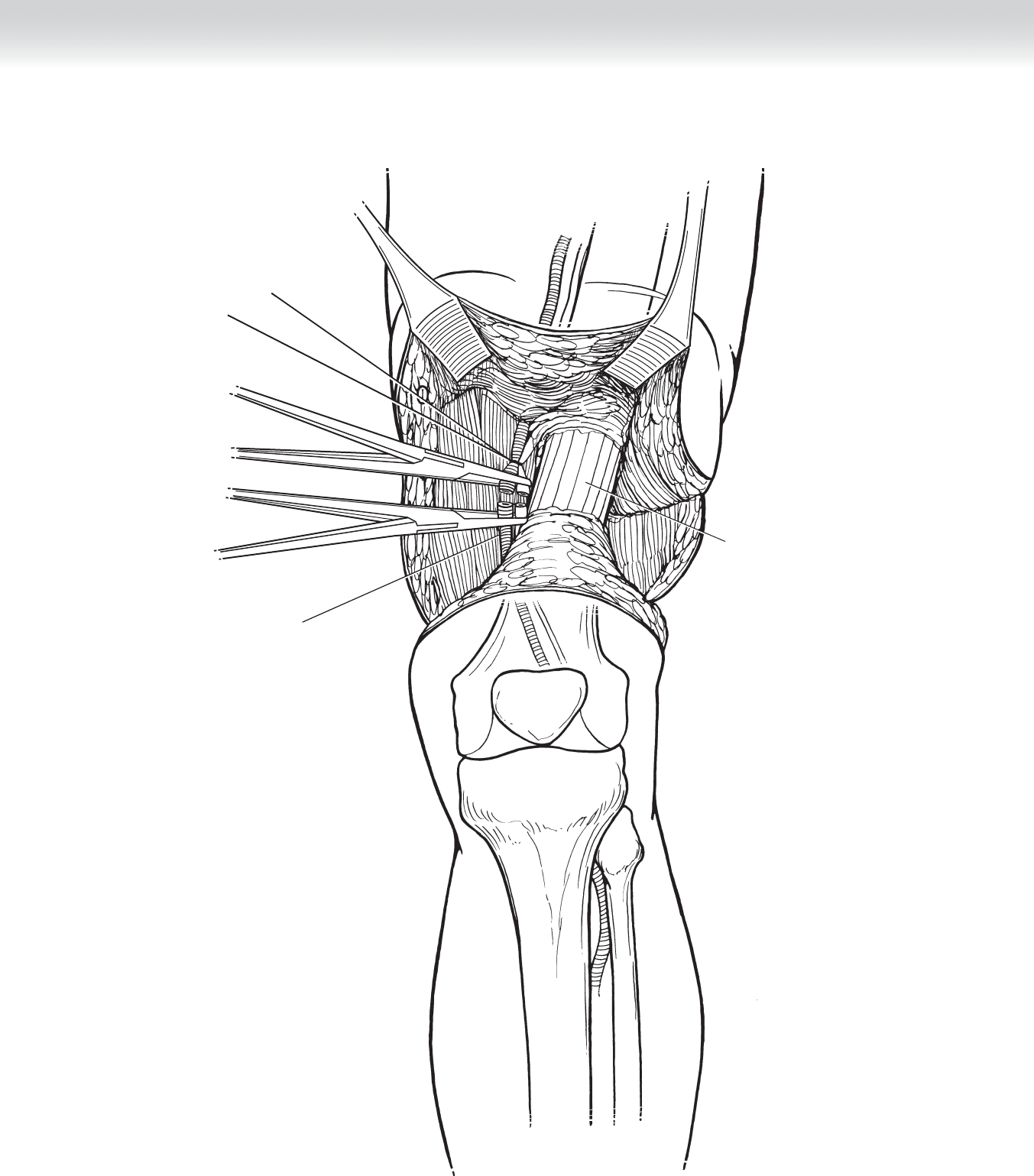
CHAPTER 94 • Supracondylar Amputation 1043
Division of femoral vessels
with sciatic nerve identified
and divided under traction
Periosteum and surrounding
tissue cleared from bone
FIGURE 94 –1

1044 Section XIII • Amputations
STEP 3: OPERATIVE STEPS
1. INCISION
◆ Proper positioning of the patient is supine. A roll can be placed under the thigh to position
the leg.
◆ The incision must be carefully planned to allow optimal skin fl ap for closure. The fi sh-
mouth–shaped incision is made using equal length posterior and anterior fl aps. The corners
of the fi sh-mouth incision should be at the level of the amputation of the femur. The length
of the fl aps should be approximately two thirds of the diameter of the thigh at that level
(Figure 94-2).
◆ The length of the fl aps should be suffi cient to provide secure, tension-free closure over the
femoral stump.
◆ The skin incision is made and extended through the subcutaneous tissue and the fascia
over the underlying muscle at the same level of the skin incision. The muscles are divided
using electrocautery at least 5 cm distal to the intended site of femur amputation and are
allowed to retract.
◆ The anterior femoral muscles are divided fi rst followed by the medial femoral muscles. The
posterior femoral muscles are divided last.
◆ A clamp can be used under the muscles to retract them and place them under traction.
◆ The muscle fl aps should be longer if myodesis/myoplasty is planned.
2. DISSECTION
◆ As muscles are divided, the nerves and vessels are identifi ed.
◆ The femoral artery and vein are found deep in the anterior medial thigh, lying adjacent to
the femur.
◆ The femoral artery and vein are isolated, double clamped, suture ligated, and divided
(see Figure 94-1).
◆ The sciatic nerve is identifi ed between the adductor magnus and biceps femoris muscles.
The nerve is placed on a gentle traction, ligated proximately, sharply divided, and al-
lowed to retract.
◆ The sciatic nerve contains relatively large arteries and therefore should be ligated.
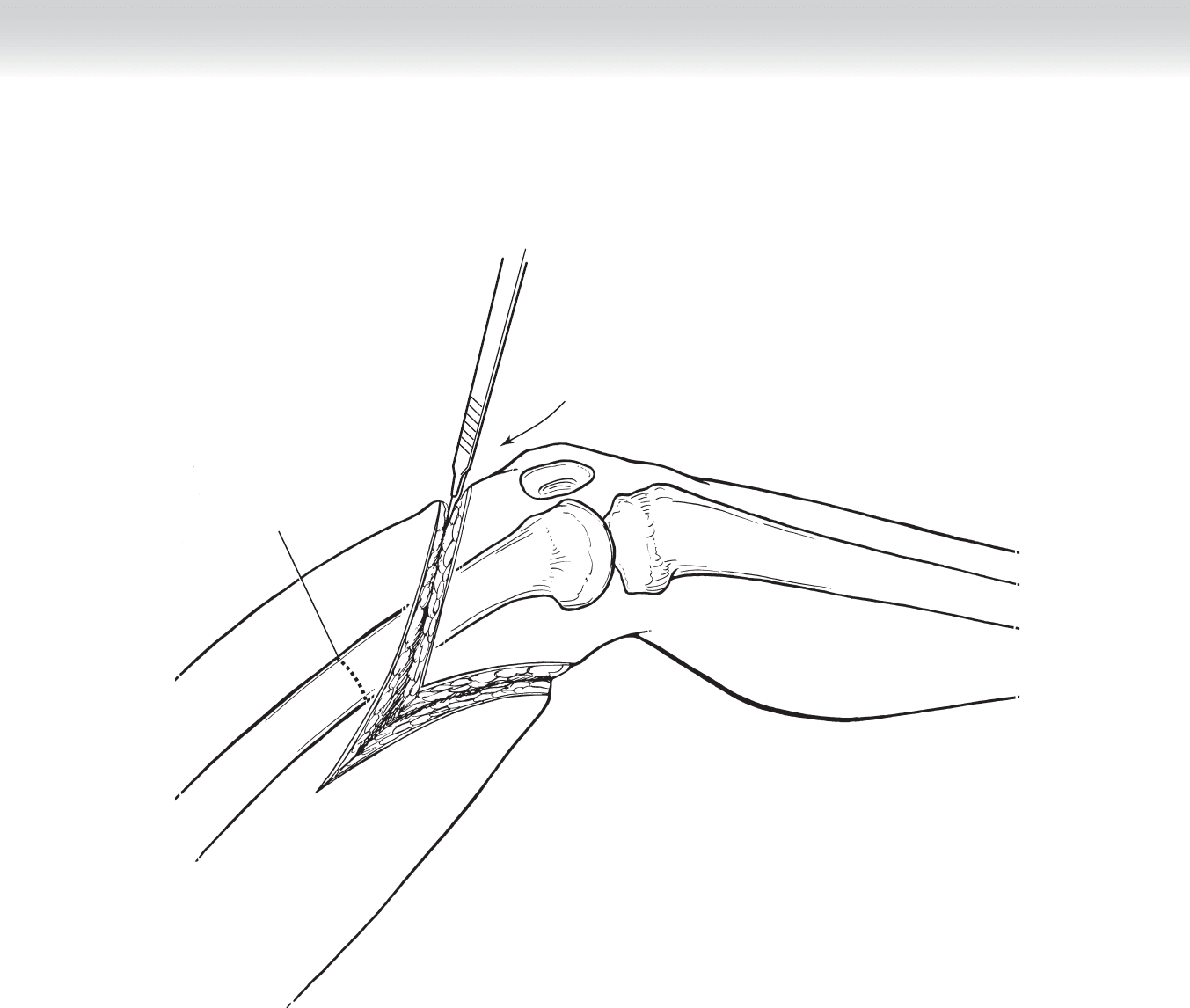
CHAPTER 94 • Supracondylar Amputation 1045
Fish-mouth incision of
skin and deep tissue
Level of division of femur
FIGURE 94 –2

1046 Section XIII • Amputations
◆ The femur is divided using a saw.
◆ After anterior muscles are divided, the periosteum of the femur is incised circumferen-
tially and is cleared approximately 2 cm distally. The femur is divided immediately distal
to the periosteal incision.
◆ The level of the femur resection is identifi ed by cutting the periosteum, but periosteum
should not be stripped from the femur. Stripping periosteum from the femur may result
in loss of blood supply to the exposed bone.
◆ The femur is divided at least 3 to 5 cm proximal to the line of skin incision.
◆ The edges of the bone should be rasped to form a smooth contour.
◆ Divided muscles are retracted superiorly for better exposure during resection
(Figure 94-3).
◆ An oscillating power saw or Gigli saw is used to divide the femur (see Figure 94-3).
3. MYODESIS/MYOPLASTY
◆ A long quadriceps fl ap with its fascia can be sutured to the posterior fascia and major
muscle groups.
◆ Several small holes (
7
⁄64 inch) are placed through the cortex of the distal end of the femur
3
⁄8 inch from the distal cut end of the femur. Loop mattress sutures are placed through the
major muscle groups and drawn through the holes.
◆ The adductor and hamstring muscles are sutured to and across the end of the femur
through the drill holes. The femur is kept in adduction as the adductors are tied down.
◆ The femur should be in full extension as the quadriceps are secured to avoid hip fl exion
contracture.
◆ Myodesis or myoplasty is performed in a nonischemic limb. It is avoided in ischemic limbs
because of increased risk of wound breakdown.
◆ If myodesis is planned, the posterior muscle fl aps are left 2 inches longer than the level
of bony transection. If both myodesis and myoplasty are planned, all muscle groups are
left long.
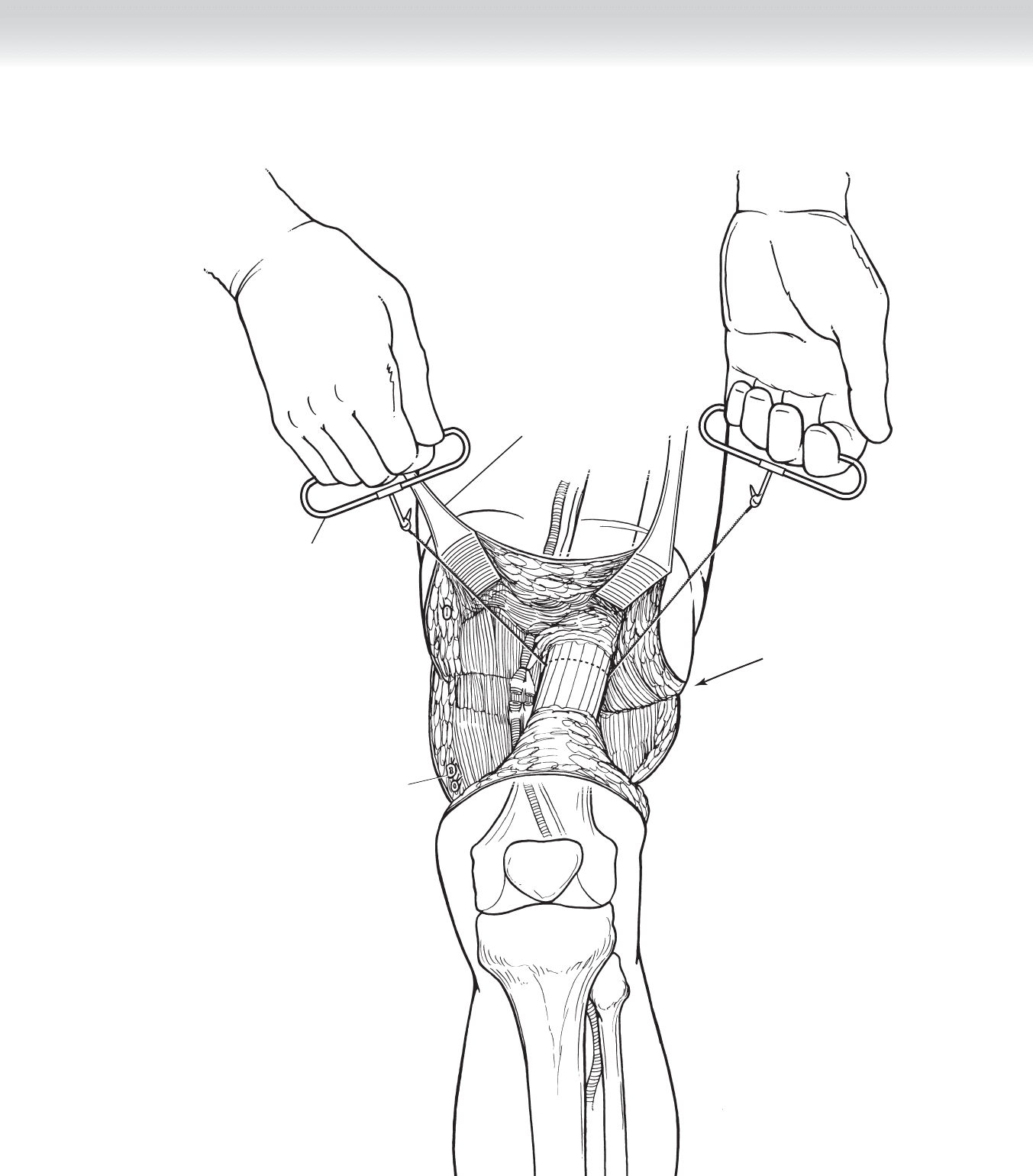
CHAPTER 94 • Supracondylar Amputation 1047
Division of femur
Soft tissue protected
by retractors
Gigli saw
Saphenous vein
ligated and divided
FIGURE 94 –3
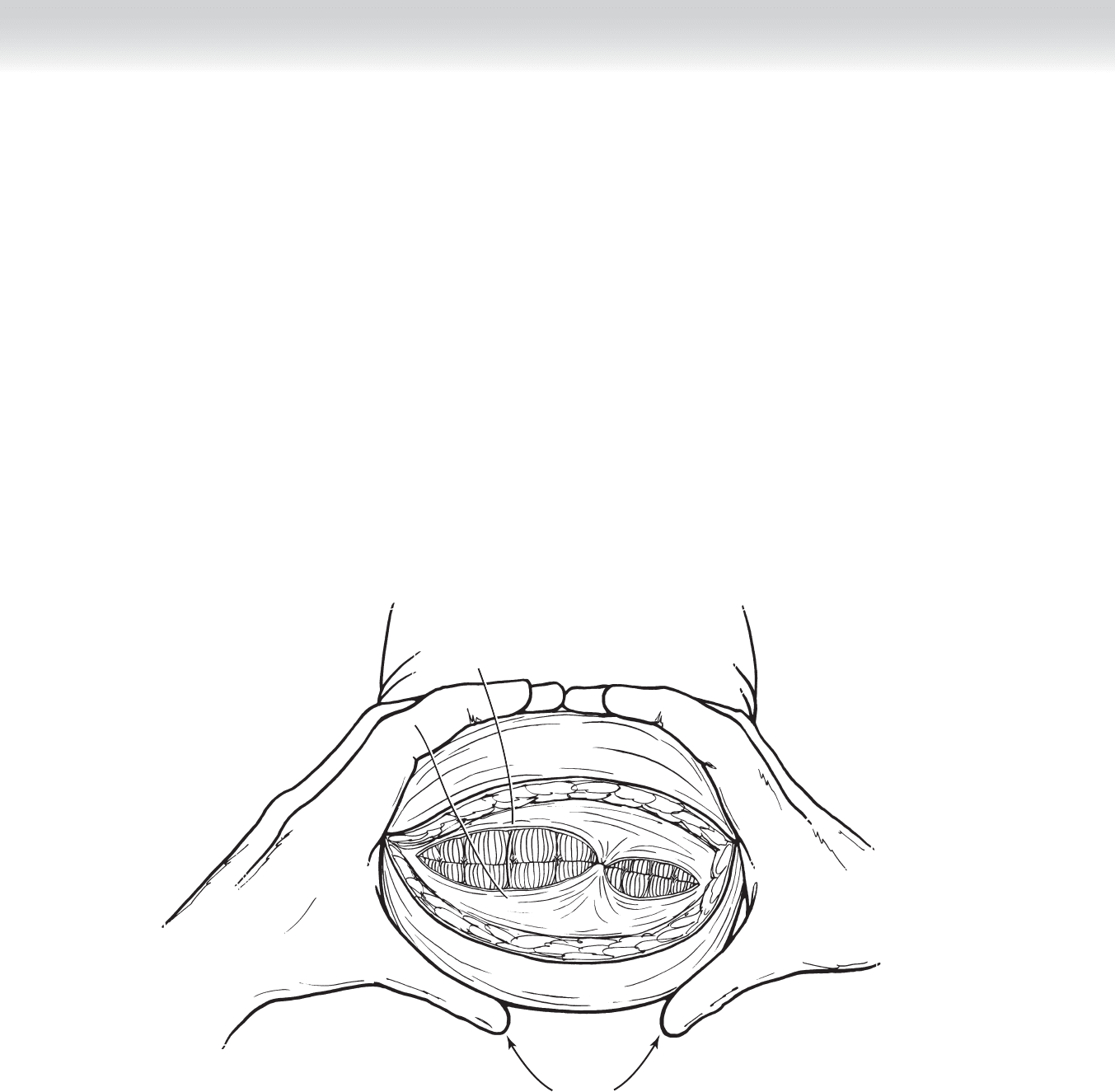
1048 Section XIII • Amputations
4. CLOSING
◆ The wound is irrigated. Once hemostasis is achieved, closure is performed by fi rst approxi-
mating the fascias of the anterior and posterior fl aps using interrupted 2-0 Vicryl sutures
(Figure 94-4).
◆ If there is persistent oozing, a drain is placed.
◆ The skin edges of the two fl aps are approximated with 3-0 nylon sutures in interrupted
fashion or with staples (Figure 94-5), which are left in for 3 weeks.
◆ After soft dressings are applied, splints may be applied. To prevent fl exion contracture of
the hip, pillows are not used for support.
Fascia and muscle are
approximated with tension
relieved by external compression
FIGURE 94–4
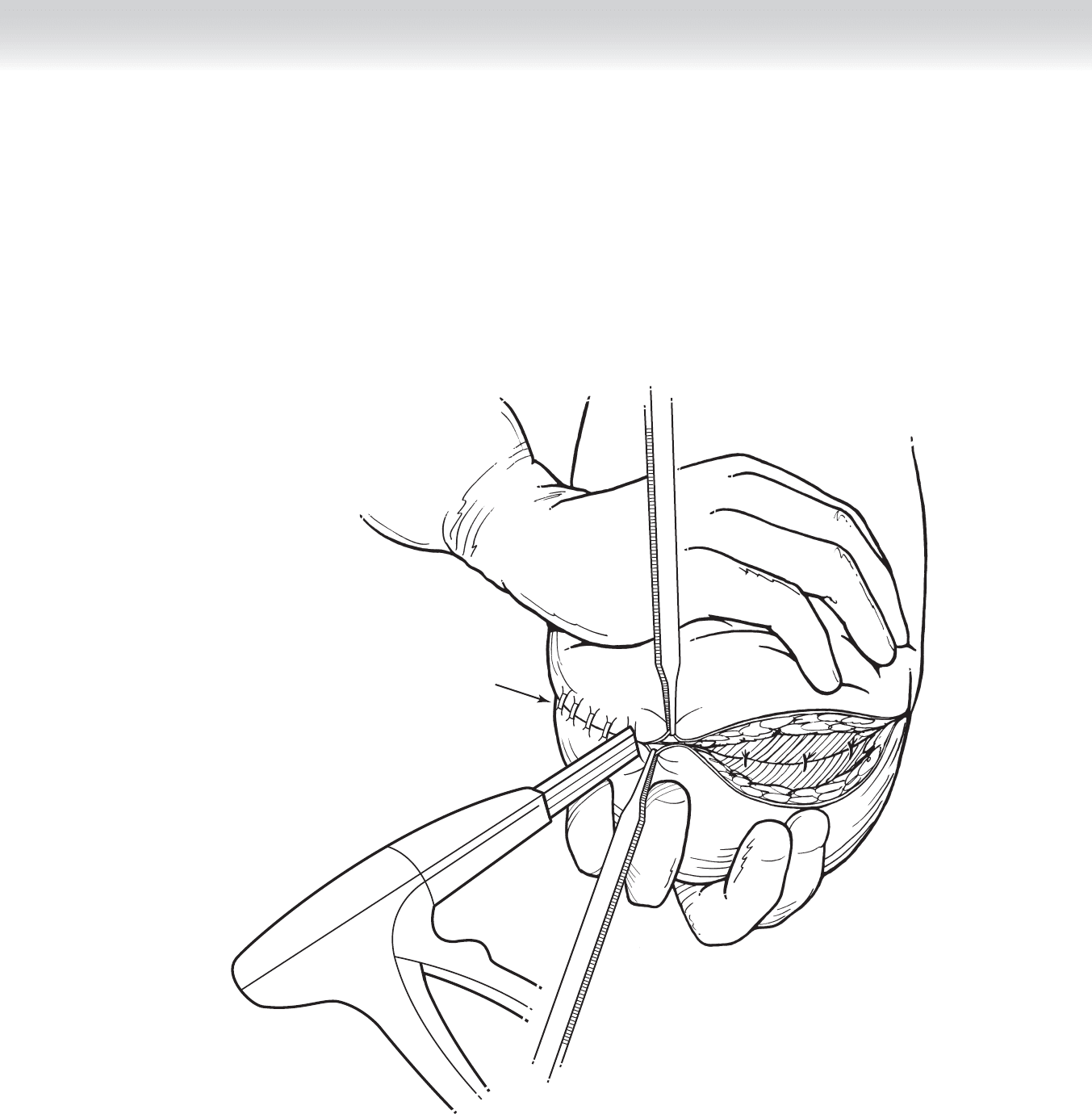
CHAPTER 94 • Supracondylar Amputation 1049
Skin closure with surgical
staples or sutures
FIGURE 94–5

1050 Section XIII • Amputations
STEP 4: POSTOPERATIVE CARE
◆ Complications include hematoma, infection, wound necrosis, and contractures.
◆ A drain may be used if there is persistent oozing.
◆ One of the most immediate postoperative complications can be wound hematoma, which
occurs in a small percentage of patients.
◆ Small hematomas can be observed.
◆ Large hematomas may need to be drained.
STEP 5: PEARLS AND PITFALLS
◆ It is imperative to handle tissues gently and attain absolute hemostasis.
◆ Guillotine amputation is used in infected leg or sepsis.
◆ A tourniquet can be used in nonischemic limbs.
◆ A tourniquet is not used in ischemic limbs.
SELECTED REFERENCES
1. Fisher DF: Lower extremity amputations. In Baker RJ, Fischer JE (eds): Mastery of Surgery, 4th ed.
Philadelphia, Lippincott Williams & Wilkins, 2001, pp 2191-2198.
2. Carnesale PG: Amputations of lower extremity. In Carnale ST (ed): Campbell’s Operative Orthopaedics,
10th ed. Philadelphia, Mosby, 2002, pp 575-586.
3. Anderson KM: Knee disarticulation and above-knee amputation. Oper Tech Gen Surg 2005;7:90-95.
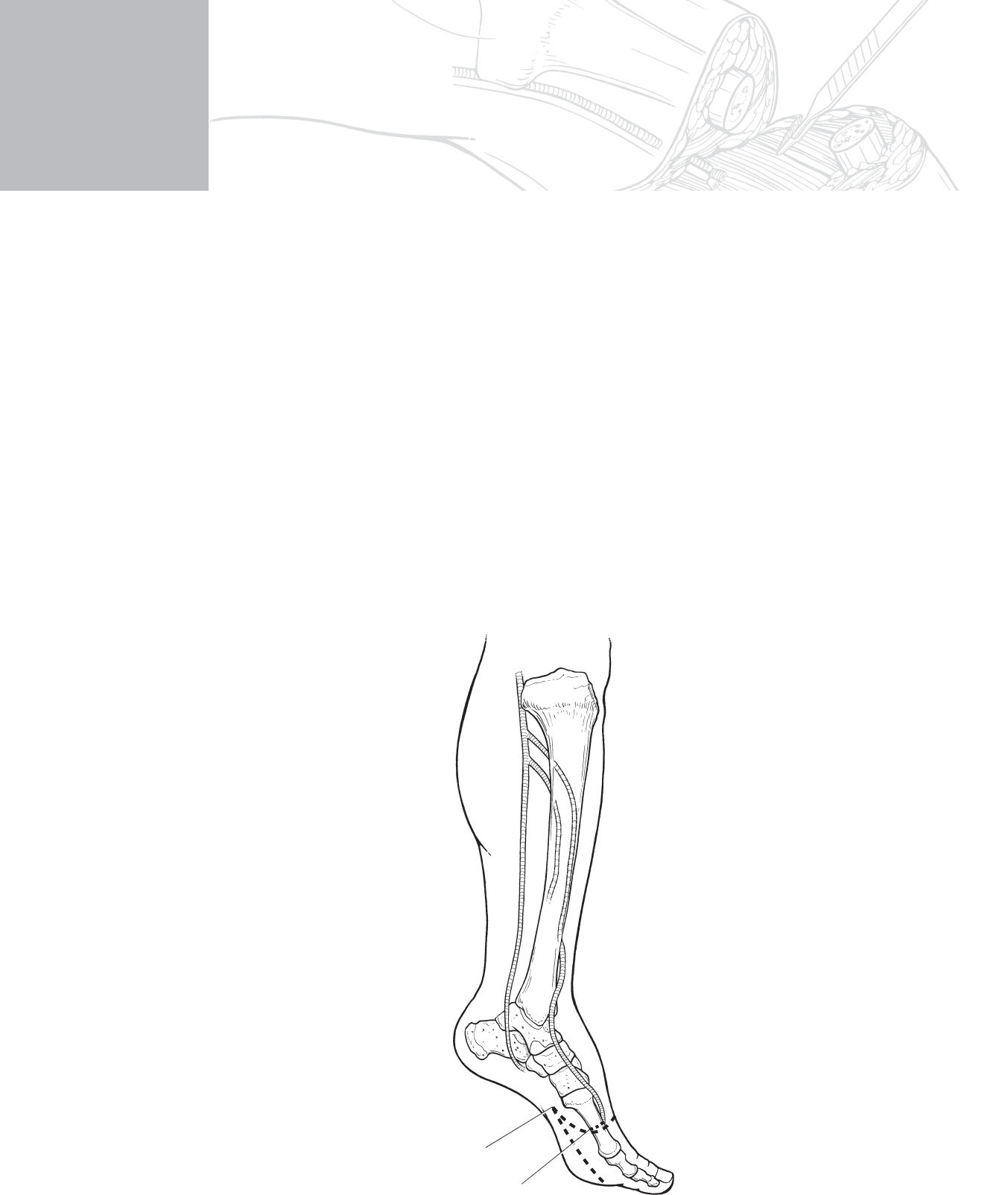
1051
INTRODUCTION
◆ Transmetatarsal amputation may be indicated for ischemic tissue loss and/or infection of the
great toe or several toes. Infection that extends proximal to the metatarsophalangeal crease
or involving the deep tissues of the foot will likely need a higher level of amputation.
STEP 1: SURGICAL ANATOMY
◆ The pertinent anatomy of the foot and lower leg is illustrated in Figure 95-1.
CHAPTER
95
Transmetatarsal Amputation
Michael D. Trahan
Line of skin incision
with acute angle laterally
Line of divison of
metatarsal at midshaft
FIGURE 95 –1
